The flags are flying in downtown Kansas City....but why aren't they promoting the Kansas 400? Maybe it's time to assess a few things
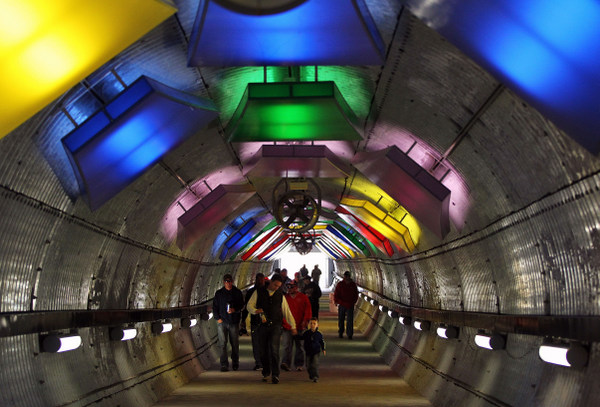
Kansas Speedway, and Kansas City, a riot of spring colors (Photo: Getty Images for NASCAR)
By Mike Mulhern
mikemulhern.net
Now nothing wrong with baseball and the All-star game, but that's three months away, and NASCAR is playing here right now. Somewhere.
Is NASCAR even relevant anymore?
Where is NASCAR still relevant?
How did we get to this situation?
To be blunt, much of the action on NASCAR tracks this season has been boring. Check Twitter and Facebook for what the fans are thinking.
Maybe sponsors need to be sampling down here on 47th and Broadway, to gauge the sport.
NASCAR execs may need to be reminded this sport is about entertainment; this should not be just an expensive exercise in technological prowess.
Aerodynamics and horsepower should not be ruling this sport. Engineers should not be running NASCAR.
NASCAR racing is about drivers showing us just how much braver and bolder they are than a rival.
NASCAR racing is about Entertainment.
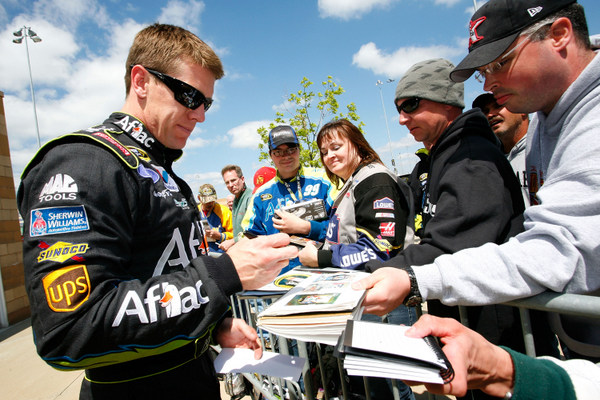
Midwestern country boy Carl Edwards, Missouri short-tracker made good (Photo: Getty Images for NASCAR)
Throw in a fiasco like the California 400, cut short by rain to half a race, and maybe part of the problem becomes even more visible.
At California the rush to get half the race in, so it would be an 'official' race, and then get the heck out of town, probably didn't set well with many of those fans.
It's been disheartening, to be honest, that so many people inside this NASCAR 'bubble' just don't seem to get that.
Consider: How far would the National Football League get if it told its customers "Gee, you got to see the first half, but now the weather's too bad, so y'all go on home."
Half a game is good enough?
That's not a great marketing program, especially for tough-nut Los Angeles.
Another issue that is becoming increasingly visible, at least apparently in the eyes of some fans – boring Sprint Cup races.
Strung-out racing has become a serious problem for this sport.
At California, for example, there was just one pass for the lead under green. And there really wasn't all that much great passing last weekend at Texas.
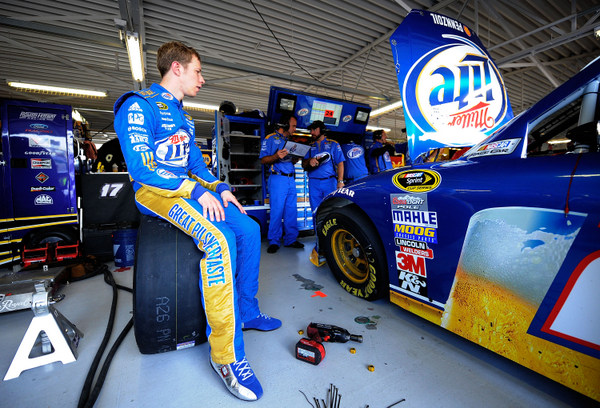
Brad Keselowski: a few inconvenient truths for NASCAR and stock car fans to consider (Photo: Getty Images for NASCAR)
Come to think of it, how many passes for the lead under green have we seen lately, discounting green flag pit stops?
Maybe not as many as there could be, or should be.
Consider this: Through the first seven races last season there were 45 cautions for wrecks or other incidents out on the track; this season so far just 25. (The number of 'debris' cautions has held steady at about 15.)
Drivers aren't wrecking as much.
Which of course is good in a sense, because no one wants to see a bunch of wrecks.
But Brad Keselowski, who won this race a year ago, points out an inconvenient truth in this: "Aerodynamics are taking over the sport and we can't get close enough to each other to wreck each other.
"That's the reality of it.
"When you can't get close to someone because aerodynamic effects of the cars, the potential to wreck is a lot less, no matter what the situation. It doesn't matter if you're angry or not angry; you can't get there (to a rival's bumper) to do anything."
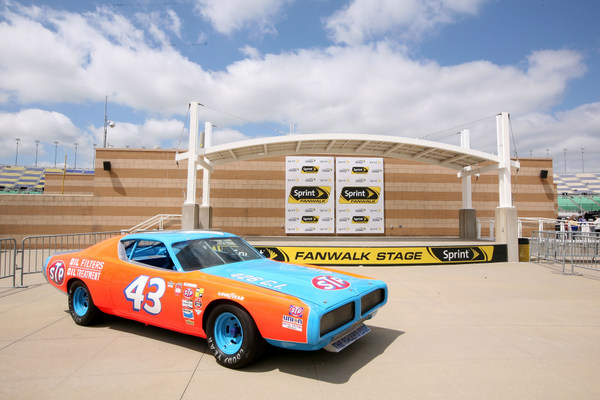
Ah, good ol' 43, back from 1971. Or was it 1972? Back when teams didn't need to have engineers or wind tunnels or seven-post shaker rigs to figure out how to put on a good show (Photo: Getty Images for NASCAR)
A corollary to that is in the physics of the issue – the faster an object goes, the more sensitive it is to aerodynamics.
Ergo, lessen the effects of slick aerodynamics by simply slowing these cars.
NASCAR racing, remember, should be entertainment, not some exercise in high-tech engineering.
Has this sport devolved into a game of 'my engineers are better than your engineers'?
Shouldn't NASCAR racing be about drivers racing side by side with each other?
One studious fan of this sport says yes, and Michael Daly (who may have a better handle on NASCAR history than anyone else following the sport) offers two clear-cut examples:
The 1977 Winston Cup race at Ontario (Calif.) Motor Speedway, which was a copy of square-shaped Indianapolis Motor Speedway. Remember how less-than-thrilling NASCAR races at Indy have become, because the turns are flat, the straights are so long, and the speeds are so high. And now consider this classic action at Ontario, when speeds were much, much slower: http://bit.ly/HAERRb
And to show that's not a one-off, here's the 1978 race: http://bit.ly/HJfhgD
Maybe NASCAR could perk up the action by simply slowing the cars. Is there any particular reason drivers need to be running 208 mph into the corners? Do fans in the stands carry radar guns?
Would you rather see two guys strung out at 200 mph, or two guys side by side at 180 mph?
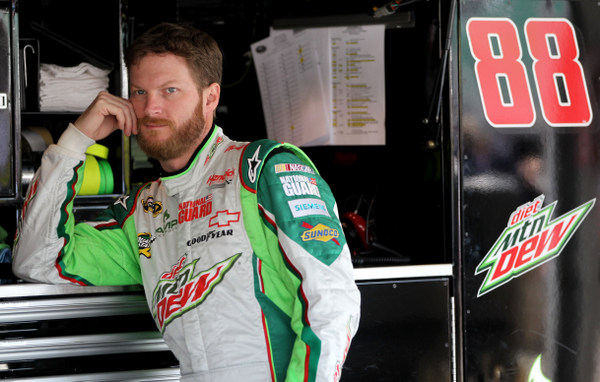
Wonder what Dale Earnhardt Jr. thinks about all this? (Photo: Getty Images for NASCAR)
Reconsidering the California 400: The weather front moving in was clearly visible on radar two days out. Plenty of time to come up with an alternative game plan.
The solution would seem painfully obvious: start the California 400 two hours early. At 10 a.m. PT, instead of noon. That's 1 p.m. ET.
Make the announcement Friday, when the weather situation first began developing.
Print on the tickets: 'In case of bad weather, this race may be started earlier.'
Fans at the track, some 80,000 strong, would have gotten to see a full race. And fans in front of their TV would have seen a full race too.
Instead, what was presented was half a race, with just one pass for the lead under green.
One driver even rushed from the track to his airplane before the race was even officially called.
The Los Angeles crowd – which track boss Gillian Zucker and first lieutenant David Talley worked hard for a full year to promote – got zapped.
And that crowd had no 'next week' venue to fall back on.
Maybe the 'half-a-race is good enough' rule is simply out of date. Far out of date.
For the prices fans have to bear these days, they ought to be getting their money's worth.
And at California they didn't.
Plus, for that particular crowd the next nearby NASCAR race would be at Sonoma in June, 500 miles to the north, or Phoenix in November, 300 miles to the east, or Las Vegas, three hours north but next March.
The way the California 400 was handled was simply not acceptable in this day and age. Particularly for a major market like that, a market that this sport desperately needs to succeed in.
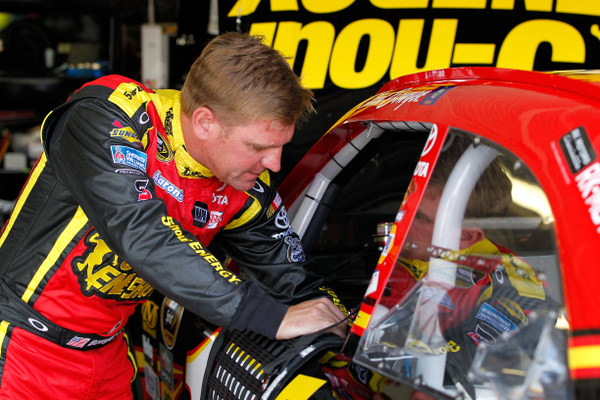
Another good Midwestern racer: Clint Bowyer. But if short-track racing doesn't pick up, where's the next one coming from? (Photo: Getty Images for NASCAR)
Why not better racing at this sport's big speedways?
Some say the tires are just too good these days.
Certainly Goodyear has been pounding out solid tires the last few years, keeping well ahead of the technological games teams play.
And Goodyear doesn't like to see right-fronts fail.
Greg Biffle says his campaign to get Goodyear to go to a different left-side tire here, which he says would improve the racing, didn't get very far.
Hamlin says back in the day when tires wore out before the gas ran out, the racing may have been better: "You had to maintain your tires; and it wasn't about lasting a fuel run. You just had to run as long as your tires would let you.
"I think all the drivers would agree that was better racing.
"(However) our cars (today) just have so much horsepower and so much downforce that Goodyear is just stuck in a box, in the sense of having to give us a hard tire to keep us from running 225 miles per hour.
"We'd love to race to the limits of the tires. But we've seen, like when we had too-soft a tire at Charlotte in '05, it would last 15 laps and everyone would blow a tire.
"And you don't want to get into an Indy (2008) thing again….
"It's a tough balance. Really I just wish all the tires had more rubber to start and just went down to the cords by the end. But that's a risk they really don't want to take."
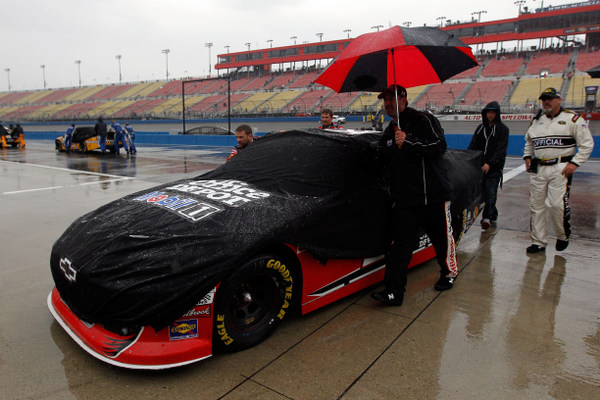
The California 400, or rather the rain-shortened California 258, was not NASCAR's finest marketing event. What would NFL fans say if a game was called at halftime? Here Tony Stewart's crew pushes the winning car toward victory lane (Photo: Getty Images for NASCAR)
And you can hear some of the frustration in Hamlin's voice: "It's whoever has the most horsepower and downforce wins.
"The cars mean so much when you're running fast speeds. Horsepower and downforce on fast race tracks, on new-paved race tracks, mean more than what any driver could possibly make up.
"(Then) you look at Atlanta for instance, where it's not always the best car that wins; it's the driver who has a good car and maintains his tire strategy."
So NASCAR racing has become just a big chess game of 'track position,' rather than gutsy drivers going deeper into the corner than a rival?
Hmmmm.
"The (clean) air is so much better up front, because you're running such fast speeds, that you have a huge advantage," Hamlin says.
"It just takes our role (as drivers) further and further out of the race car, the faster you go, because horsepower and downforce are obviously bigger factors."
Doesn't that plea beg for the obvious answer? Legendary Robert Yates began politicking for slower speeds back in 1993….to no avail.
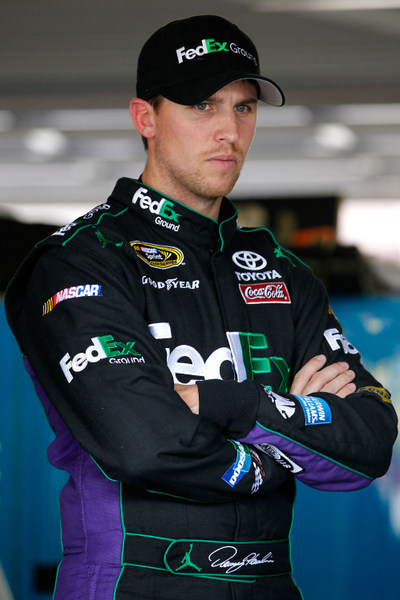
Denny Hamlin: drivers aren't wrecking because they can't get close enough to try to pass (Photo: Getty Images for NASCAR)
Consider that Texas Motor Speedway's asphalt is well-worn and tires were falling off a good two seconds over an 80-mile gas run, which drivers like. So the Texas 500 should have been a great race.
A spinoff from all that is the increasing rash of gas mileage finishes, as three of the last four Cup races here have been.
Featherfoot-racing….
Hamlin points to the obvious, that gas mileage races are created "because cautions have been cut down quite a bit.
"It's also because our tires are better. Tires aren't blowing out anymore.
"Guys aren't wrecking anymore because there's not as much overtaking. There's less chance for accidents to happen when there is less overtaking.
"That's why you're seeing more green flag runs than what we've had -- it's just so tough to pass nowadays.
Another issue to consider: the opening of the country's short-track weekly racing season.
Now there are some great race fans out here in Kenny Schrader/Carl Edwards/Clint Bowyer country. And the stands will likely be full Sunday afternoon at Kansas Speedway, a really spiffy-looking place, surrounded by a rapidly growing 'city' of its own, now complete with the Hollywood Casino. And good weather on tap.
But the weekly short-track fan-feeder system out here may need some help. That's where this sport discovered Carl and Clint and Kenny.
Think Grassroots.
The NASCAR Sprint Cup series of course is more than just about the tour's Sunday events and weekend packages and the big midway carnival.
The Cup series is a major part of American racing marketing, a focal point.
Through their highly promoted 'Home Track' ads, NASCAR execs certainly realize that.
But maybe there is still a distinct disconnect here: perhaps it's time to take a page from this sport's illustrious marketing history, when R. J. Reynolds Tobacco directly tied its Winston Cup series marketing to its weekly Winston Racing Series tracks. The synergies were amazing.
When RJR pulled out of NASCAR 10 years ago, that grassroots Saturday night energy began to die on the vine.
Where is the corporate sponsorship to tie all this together?
And this seems to be an increasingly serious issue -- a local journalist asked several Cup drivers about the marked decline in weekly short track action in the Midwest and asked what can be done, saying that most area asphalt tracks have had to close because of small crowds and short fields.
Denny Hamlin, who is promoting his own short-track charity event at Richmond International Raceway next Thursday, a Late Model race for some up-and-comers, helped explain part of the problem. One of those Richmond Late Model drivers, Hamlin said, will be running a car for that race that cost $55,000.
Read that one more time: a Late Model car that costs more than $55,000. That, frankly, is tough to accept.
How to boost fan interest in short-track asphalt racing?
Maybe TV needs to step to the plate here too.
Hamlin, an old Southside Richmond racer himself, says "I can only speak for Late Model racing in the Mid-Atlantic, but I'm sure it's probably about the same here -- it's the pay.
"I know personally Jeff Burton said he had about $55,000 to $60,000 in his Late Model that he was going to run at Richmond next weekend. That is a tremendous amount of money for local guys…and then try to win (only) $1200 to $1400 bucks…if they win.
"When my parents were making $50,000 a year (and supporting Hamlin on his rise up through the short-track ranks), it cost us $1,200 to race each week, for the fuel for the truck, the trailer, the car, all that.
"There's just not enough support paying those guys. And with the economy, everything it's tough. The Middle-class has just shrunk dramatically…
"We need to figure out, on the local short-track level, how to contain the cost. Something to try to get local short-track racing back to what it was.
"The car-counts are even struggling in the Virginia- North Carolina area, and that's what you think is the heart of short-track racing.
"Every track is struggling right now.
"I can assure you if you have 30 Late Models show up, you'll have fans in the stands. But when you got (only) 12 to 14, it's tough to watch that race.
"You'll watch a Nationwide race at home instead."
Surely these are some issues ripe for debate. And just throwing a new C-post template out on the playing field isn't going to solve any of the sport's big issues.
The Kansas City skyline, from atop the grandstands at Kansas Speedway (Photo: Getty Images for NASCAR)
© 2010-2011 www.mikemulhern.net All rights reserved.
Web site by www.webdesigncarolinas.com







Hi Mike, I really enjoy your
Hi Mike,
I really enjoy your objective comments and insight. I've been a Nascar fan since the sixties, and I hate to say, but I am one of those that is losing interest. I'm not sure why. I used to go to 3 races a year-I live in the great midwest-now I go to Michigan in August, only for old time's sake. I think they need to look at moving some races to other tracks to add variety and give fans something new. I know there are commitments that are made to track owners far in advance, but empty stands are not good either. Thanks for your work!!
Racing is a sport, one of the
Racing is a sport, one of the few. Baseball is a game. Entertainment. I hope you never get Mike Helton's spot. Horsepower SHOULD not be ruling this sport. Engineers SHOULD not be running NASCAR. That's what makes racing relevant, and more than simply entertainment. NASCAR racing is NOT about drivers showing us how brave they are, that foolishness results in death and injury. Drivers should be showing us how skillful they are, like Kyle Busch's multiple saves at Daytona.
I agree that rain-outs are a detriment to the sport, but you simply can't run a banked oval in the rain. I have no idea why NASCAR has dragged it's feet about rain races at the road courses. Maybe we need more road courses where we can race in the rain instead of multiple events at 1.5 mile tracks.
I agree that aerodynamics are a detriment to the sport. We should go back to the Sixties where you couldn't run any body modifications that weren't stock. Research in that area can improve fuel economy and allow cars to run smaller, lighter engines. Stock bodies would also reduce speeds as you suggested, and make cars safer and allow a stronger bond between consumers and manufacturers.
And before we go back to the good old days of 1971, look up how many races were won by a leader who was one lap or more ahead of the rest of the field.
I actually believe that the
I actually believe that the all of the reasons listed in the article are true, but I would like to add one more.
We left a lot of tracks that were constructed in a way that it would be impossible to go fast enough for aerodynamics to make a difference. I know that no one wants to hear another western NC boy whining about North Wilkesboro Speedway, but the design of the track meant that aero-push would never be a factor.
The only reason that anyone kept building 1.5 mile tracks was for IndyCars, and that certainly didn't work itself out well. Also, Bruton proved that you can make money off of a .5 mile speedway.
There is no reason that someone couldn't replicate a North Wilkesboro layout in Kansas, Fontana, or anywhere in the U.S.. Would the car owners be mad about torn up cars? Absolutely. Would the drivers be mad because they were shoved out of the way by a teammate for the win? Yes, and it would be wonderful!
So here is the solution. Turn Fontana into North Wilkesboro, turn Chicagoland into the old Nashville track, and turn Kansas into one of those mid-western sprint car tracks like Lake Side Speedway (paved, or go crazy and leave it dirt - those Kansas folks would love some of that). Then finally add Iowa to the schedule.
You'd be writing stories about bent fenders and hurt feelings, not aero-push and overpaid drivers sprinting to their luxury jets to leave the track. I know you'd like that.
Reply to comment
I think you have hit the nail
I think you have hit the nail on the head twice. Nascar has become the race of engineers, (puke)..Sorry but that's what drove me away little by little. Fuel mileage runs turn me off too. Nascar drove Goodyear to build the tires we have today and they have done a fine job. You can't fault them for that.
NASCAR is like our goverment. If they are heading something up you can count on it being screwed up. Can you say FUEL IN-JEC-TION.
One other huge factor is the
One other huge factor is the COT - in the effort to become safer, these beasts were designed pretty much bulletproof - the drivers have no fear of scraping a wall or doing a little door-banging as usually it doesn't even knock the toe out. In days gone past, there was a penalty to be paid if incidental contact was made - the frontend alignment may get knocked out, the rear end may get bent - something happened to cause issues. As to latemodels, though all in the best interest of special events, big-name drivers are showing up all over the place with NASCAR-quality stuff, and local racers are blindly spending to compete. Then they have these high-dollar cars dominating the local scene, causing a spending war that keeps upping the barrier to competition. Also, the trickle-down effect of NASCAR tech is infiltrating everything to do with late models, from data-aquisition on test days, to $10,000 shock packages and for-hire shock specialists, to areo, to 9000RPM solid-liter engines, to bumpstops and swaybars to ??? If the NASCAR guys really wanted to do something special, something like Kimmell's Street Stock Shootout would make way more sense.
I too started watching NA$CAR
I too started watching NA$CAR in the sixties but over the years have gone back to my first love, dirt racing with full fields and great racing. NA$CAR is too much a rich man's sport now, tickets etc. and for less than 150.00 can see a two day late model show including hotel and be happy. Sad but true, NA$CAR is boring and rather watch on TV or DVR and watch later. And yes too many small tracks are closing and no one can afford to race.
slow down the cars, do away
slow down the cars, do away with the front splitter, limit the rear spoiler to 3 inches, lowest point of the car must set 4 inches off the ground and force the teams to run a stock grill out of the car they are reping with NO TAPE!! This would put racing back in the hands of drivers, not engineers. These simple moves would cost very little to implement to the current car and would produce great racing again!!!!!!!
Maybe if Nascar raced at a
Maybe if Nascar raced at a few more short tracks each season it would help fans get back into short track racing. I actually forgot they were racing today at Kansas until the Flyers/Penguins game was over and changed the channel and that never happens to me. If they were at a short track or a better track I would of remembered and atleast DVR'd the race. I've been to over 200 cup races and a season high of 13 in 88 but some of the racing at some of these tracks is so bad I don't want to watch it. It started going down hill after the 94 season.
Mike,Your piece really hits
Mike,
Your piece really hits home on the multitude of problems facing Nascar today. Being a fan since the late 70's, this can't really be called racing..it's a lesson in high-dollar engineering. Let's try a few races with the old bias-ply tires and see who can wheel a race car to the checkered flag. We used to go to Bristol. Atlanta and Talledega twice a year for years..wouldn't waste the time nor money to attend and sit thru a race today. Absolutely pitiful!!! It's getting painful to sit at home and watch this and try to act like it's decent racing.
Hi Mike I enjoyed your comment on lack of
Hi Mike I enjoyed your comment on lack of interest at the Plaza area. Overall the plaza is in Missouri not Kansas. And it seems that part of town is for a different type of person. The whole town should be part of welcoming the visitors to Kansas City. I was disappointed with the local lack of tv coverage. I hope this fall they will pick it up.